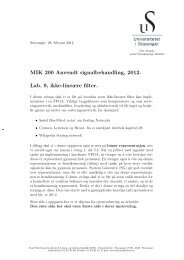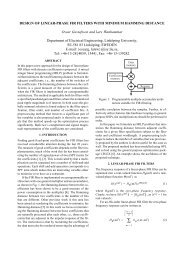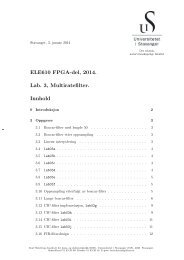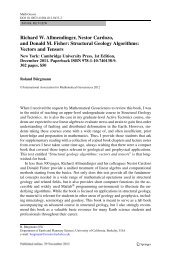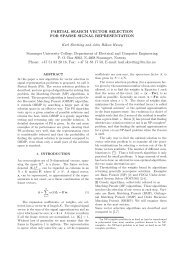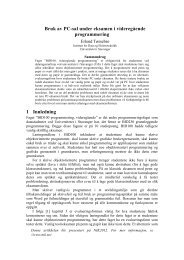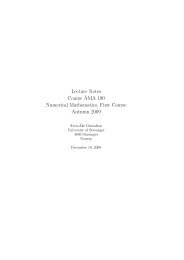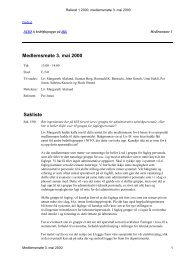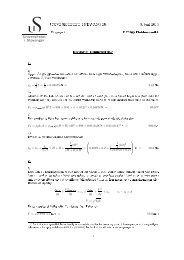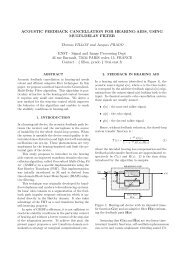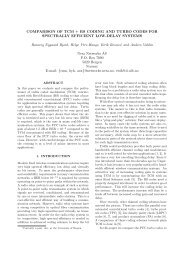MODELING OF LOW SALINITY EFFECTS IN SANDSTONE OIL ...
MODELING OF LOW SALINITY EFFECTS IN SANDSTONE OIL ...
MODELING OF LOW SALINITY EFFECTS IN SANDSTONE OIL ...
You also want an ePaper? Increase the reach of your titles
YUMPU automatically turns print PDFs into web optimized ePapers that Google loves.
4 OMEKEH, EVJE, AND FRIISunder full reservoir conditions. In particular, different water-oil relative permeability curves forhigh and low salinity water was reported. Berg et al. [9] devised an experiment where they wereable to film the release of oil droplets bonded to clay layers when the clay layers were exposed tolow salinity water in a flow cell. The authors attributed this release of oil droplets to either doublelayer expansion or cation exchange.The above review deals with experimental related works. We now mention some of the modelingrelated work we are aware of which seems relevant for low salinity flooding experiments.The authors of [22], [41] and [47] modeled beneficial low salinity effects by directly linking thebrine salinity to the flow conditions (relative permeability and/or capillary pressure). Using thisprinciple, Tripathi et al. [41] studied flow instability at the saturation fronts. Jerauld et al. [22]studied the dispersion at the saturation front. Yu-shu and Baojun [47] included the possible adsorption/desorptionof salt but did not link the adsorbed salt to improved flow functions. Twohighly interesting works, in view of the proposed model (1), are represented by [38] and [29]. Theystudied a general system of the form(2)s t + f(s, c) x = 0,(cs + a(c)) t + (cf(s, c)) x = 0,for n components c = (c 1 , . . . , c n ). If diffusion effects are ignored in model (1), it can be consideredas a special case of (2). The authors of [38] and [29] introduced a reformulation of themodel by employing a coordinate transformation which decouples the hydrodynamic part fromthe thermodynamic. Hence, they could produce analytical solutions for various problems. Suchtechniques could most likely be used for our model to allow for fast calculations. However, it isbeyond the scope of this work since the main objective here is to obtain a model which can beused to test various hypothesis for how low salinity effects may impact the oil recovery. We wouldalso mention that the model (1) is a generalization of the one studied in [45, 46] in the sense thatin those works only adsorption of a single component is considered, not a multiple ion exchangeprocess involving several components.Finally, the model we are presenting in this paper has been used in [28] to explain the behaviorobserved in some low salinity waterflood experiments where expected low salinity improvedrecovery were not seen.1.4. Structure of paper. The rest of this paper is organized as follows: In Section 2 we mathematicallydescribe the multiple ion exchange process built into the flow model. In Section 3 weexplain how the MIE process is linked to a change of the wetting state as represented by two setsof relative permeability functions referred to as high salinity and low salinity conditions. Section4 gives a presentation of the flow equations where the two-phase flow and ion concentration flowdynamics are accounted for. In Section 5 some details are given of the numerical approach usedto solve the coupled system (1). Finally, Section 6 presents a number of different flow cases whosepurpose is to illustrate basic features of the model as a tool to explore the relation between thebehavior of the MIE process and oil recovery curves.2. Modeling of the multiple ion exchange (MIE) processIn this section we describe the multiple ion exchange process we shall rely on in this work.2.1. Generally. We distinguish between concentration C and chemical activity a noting thatthey are related by(3) a = γC,where γ is the activity coefficient. According to the extended Debuye-Hückel equation, see forexample [4, 25] and [27] (page 25), the activity coefficient γ i is given by√I0(4) log 10 (γ i ) = −AZ2 i1 + a 0 i B√ + bI 0 ,I 0where the index i refers to the different species involved in the system which is studied. Moreover,Z i refers to the ionic charges, b is an extended term parameter, A(T ) and B(T ) are temperature



